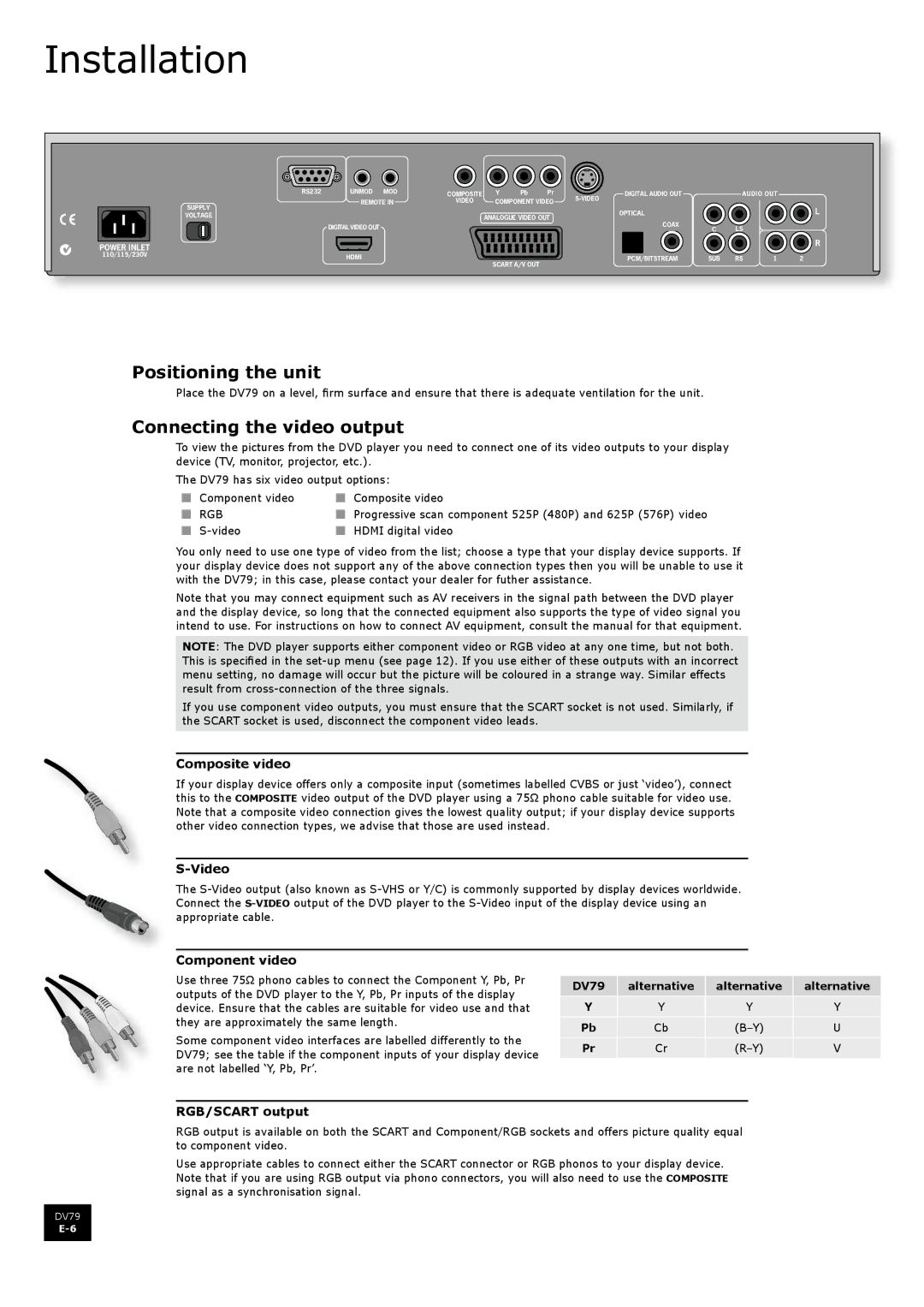
Installation
RS232 | UNMOD MOD | COMPOSITE | Y | Pb | Pr | DIGITAL AUDIO OUT |
| AUDIO OUT |
| ||
SUPPLY | REMOTE IN | VIDEO | COMPONENT VIDEO |
|
|
|
|
| |||
|
|
|
|
|
| OPTICAL |
|
|
| L | |
VOLTAGE |
|
| ANALOGUE VIDEO OUT |
|
|
|
| ||||
|
|
|
|
|
|
|
| ||||
|
|
|
| COAX |
|
|
|
| |||
| DIGITAL VIDEO OUT |
|
|
|
|
| C | LS |
|
| |
|
|
|
|
|
|
|
|
| |||
POWER INLET |
|
|
|
|
|
|
|
|
|
| R |
|
|
|
|
|
|
|
|
|
|
| |
110/115/230V | HDMI |
|
|
|
|
| PCM/BITSTREAM | SUB | RS | 1 | 2 |
|
| SCART A/V OUT |
|
| |||||||
|
|
|
|
|
|
|
|
|
| ||
Positioning the unit
Place the DV79 on a level, firm surface and ensure that there is adequate ventilation for the unit.
Connecting the video output
To view the pictures from the DVD player you need to connect one of its video outputs to your display device (TV, monitor, projector, etc.).
The DV79 has six video output options:
n Component video | n Composite video |
n RGB | n Progressive scan component 525P (480P) and 625P (576P) video |
n | n HDMI digital video |
You only need to use one type of video from the list; choose a type that your display device supports. If your display device does not support any of the above connection types then you will be unable to use it with the DV79; in this case, please contact your dealer for futher assistance.
Note that you may connect equipment such as AV receivers in the signal path between the DVD player and the display device, so long that the connected equipment also supports the type of video signal you intend to use. For instructions on how to connect AV equipment, consult the manual for that equipment.
NOTE: The DVD player supports either component video or RGB video at any one time, but not both. This is specified in the
If you use component video outputs, you must ensure that the SCART socket is not used. Similarly, if the SCART socket is used, disconnect the component video leads.
Composite video
If your display device offers only a composite input (sometimes labelled CVBS or just ‘video’), connect this to the COMPOSITE video output of the DVD player using a 75Ω phono cable suitable for video use. Note that a composite video connection gives the lowest quality output; if your display device supports other video connection types, we advise that those are used instead.
S-Video
The
Component video
Use three 75Ω phono cables to connect the Component Y, Pb, Pr outputs of the DVD player to the Y, Pb, Pr inputs of the display device. Ensure that the cables are suitable for video use and that they are approximately the same length.
Some component video interfaces are labelled differently to the DV79; see the table if the component inputs of your display device are not labelled ‘Y, Pb, Pr’.
DV79 | alternative | alternative | alternative |
Y | Y | Y | Y |
Pb | Cb | U | |
Pr | Cr | V |
RGB/SCART output
RGB output is available on both the SCART and Component/RGB sockets and offers picture quality equal to component video.
Use appropriate cables to connect either the SCART connector or RGB phonos to your display device. Note that if you are using RGB output via phono connectors, you will also need to use the COMPOSITE signal as a synchronisation signal.
DV79
